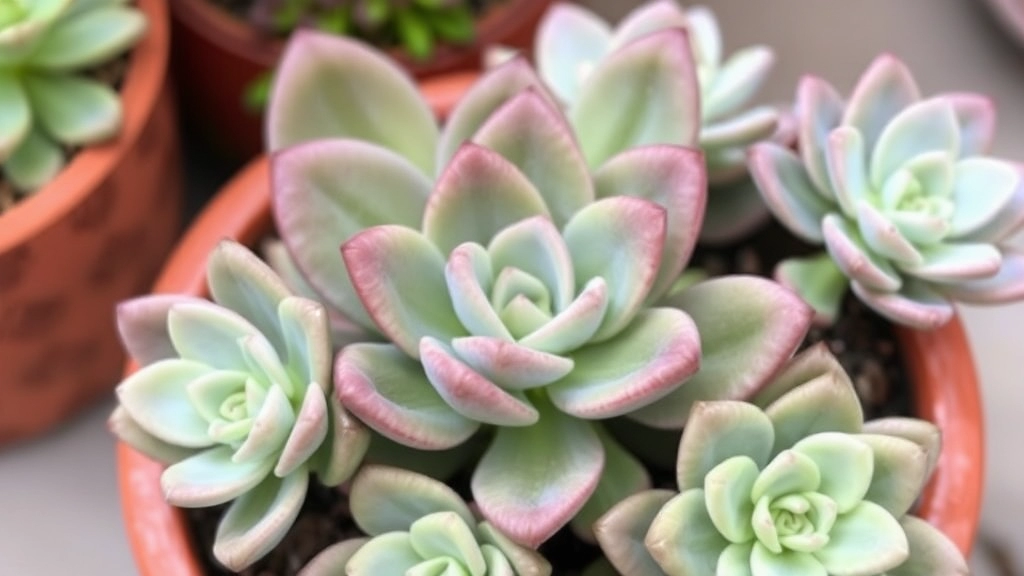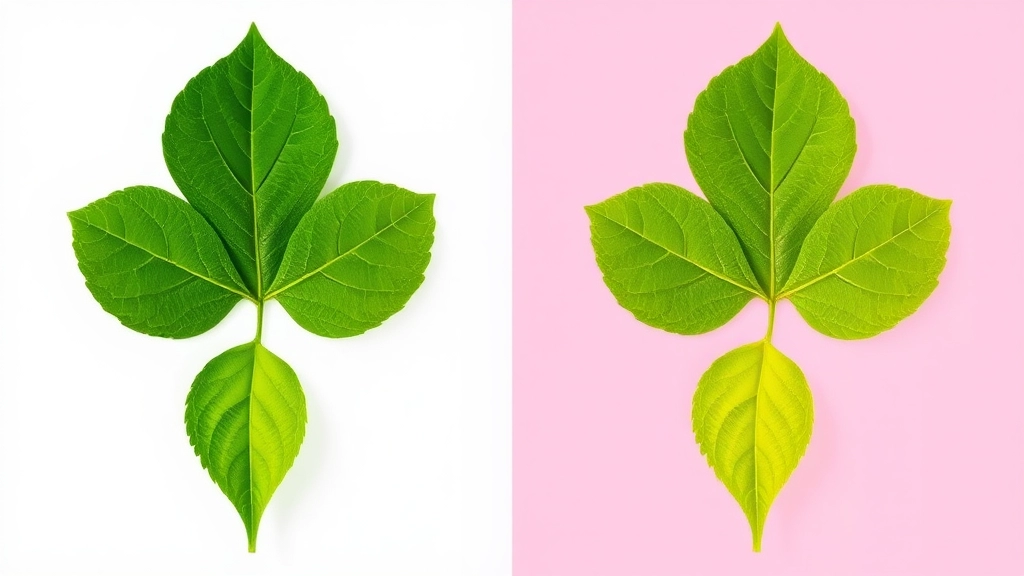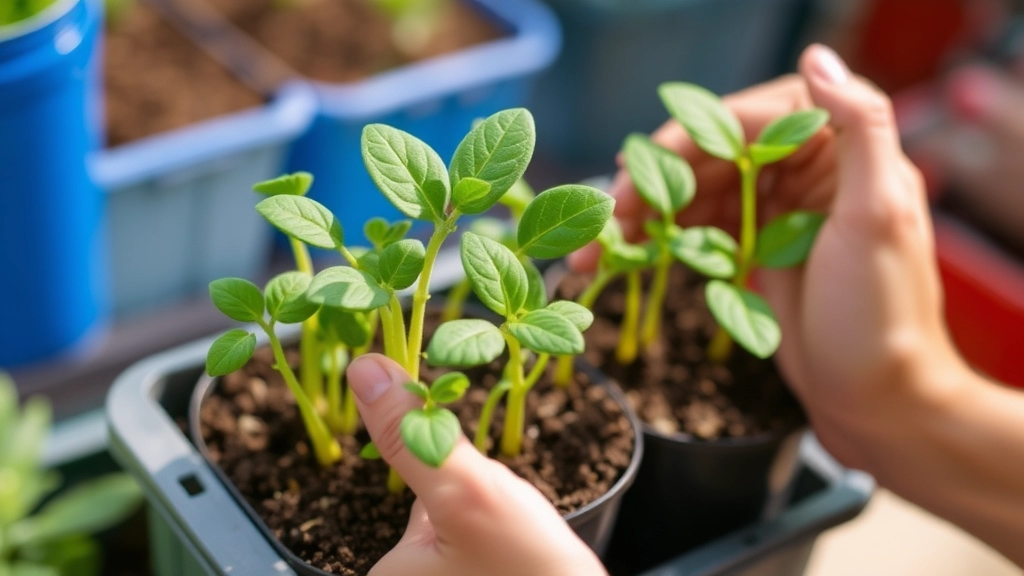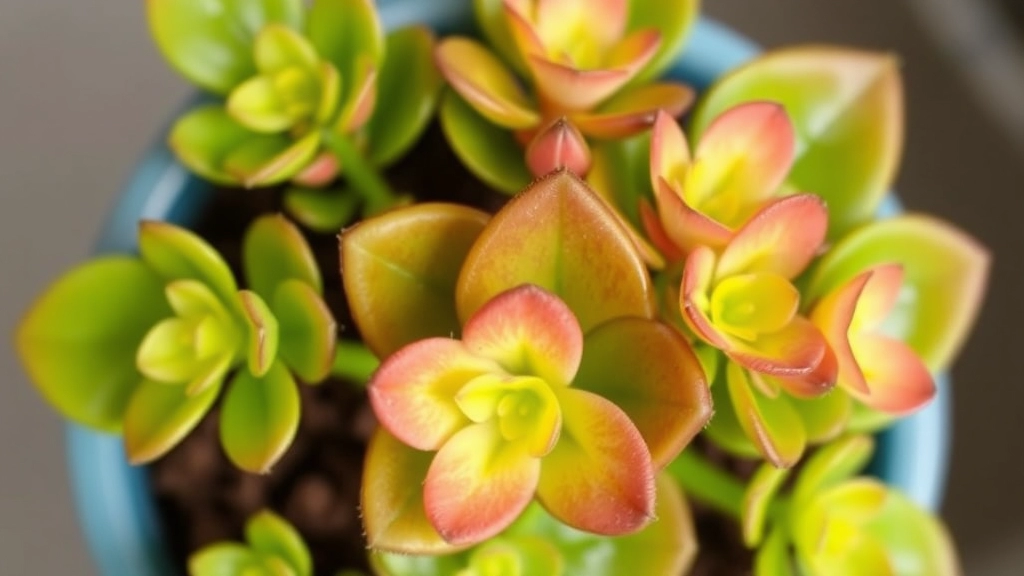Kalanchoe Succulents: Identification and Care
If you’re diving into the world of Kalanchoe succulents, identifying different varieties can be both exciting and challenging. Kalanchoe succulents, like Kalanchoe Blossfeldiana and Tomentosa, boast a range of unique traits, from thick, succulent leaves to waxy coatings and distinct leaf shapes. Recognising these features is key to proper identification.
Flowering patterns also play a crucial role in Kalanchoe identification. Some species, like the popular blooming Kalanchoe, have specific care requirements to thrive. Understanding their leaf shapes and color variations, such as paddle-shaped or scalloped leaves in hues of green, purple, or variegated, can further aid in distinguishing between different types. By focusing on these unique characteristics, you can confidently identify and care for your Kalanchoe succulents.
Common Kalanchoe Varieties
When exploring the world of Kalanchoe, you may wonder which varieties are most popular and suitable for your collection.
Kalanchoe is a diverse genus, boasting numerous species that cater to various tastes and environments.
Here are some of the most common Kalanchoe varieties you might consider:
- Kalanchoe blossfeldiana: Known for its vibrant flowers, this species is often used in arrangements and as a houseplant. Its blooms can be red, pink, yellow, or white, providing a splash of colour. For a comprehensive guide, check out the ultimate guide to Kalanchoe blossfeldiana hybrid care.
- Kalanchoe tomentosa: Often called “Panda Plant,” this variety features fuzzy, grey-green leaves with distinctive brown edges. It’s a delightful choice for those who appreciate unique textures. To ensure healthy growth, refer to the how to grow and care for Kalanchoe tomentosa.
- Kalanchoe luciae: Commonly referred to as “Flapjack,” this succulent has large, flat leaves that turn a stunning red when exposed to bright sunlight. It’s a showstopper in any collection.
- Kalanchoe beharensis: Known as “Chandelier Plant,” this variety has large, thick leaves with a unique, wavy edge. It can grow quite tall, making it a striking addition to any space.
- Kalanchoe marmorata: Often called “Pencil Plant,” it features beautiful marbled leaves and can produce clusters of small, tubular flowers.
These varieties not only differ in appearance but also in their care needs and growth habits.
Unique Traits of Kalanchoe Succulents

Ever found yourself wondering what makes Kalanchoe succulents so special?
These plants are not just pretty faces; they come packed with unique traits that set them apart in the succulent world.
Resilience
Kalanchoes are tough cookies.
- They thrive in various conditions.
- They can handle drought like pros.
This resilience makes them perfect for beginners or anyone who might forget to water their plants now and then.
Varied Leaf Shapes and Textures
One of the coolest things about Kalanchoes is their diverse leaf shapes and textures.
- Some have smooth, glossy leaves.
- Others feature serrated edges or a fuzzy texture.
This variety adds visual interest to any plant collection.
Colourful Displays
Kalanchoes are like the artists of the succulent family.
- Their leaves can be shades of green, grey, red, or even purple.
- Some varieties boast stunning patterns.
This colourfulness makes them a standout in any garden or indoor space.
Unique Growth Habits
These succulents often grow in a rosette shape, which is not just pretty but also practical.
- The rosette formation helps them conserve water.
- It allows them to capture sunlight efficiently.
This unique growth habit is a key reason they’re so popular.
Medicinal Properties
Did you know some Kalanchoe species are known for their medicinal benefits?
- They’ve been used in traditional medicine for various ailments.
- Some people swear by their healing properties.
It’s a fascinating aspect that adds to their charm.
Flowering Kalanchoes
Are you wondering how to encourage your Kalanchoe to bloom?
Flowering Kalanchoes are not just a beautiful addition to your home; they can also be a source of joy and pride for any plant enthusiast.
Understanding Flowering Kalanchoes
Kalanchoe plants are famous for their vibrant blooms, which can transform any space into a lively oasis.
Here are a few popular flowering varieties:
- Kalanchoe blossfeldiana: Known for its clusters of small, colourful flowers.
- Kalanchoe thyrsiflora: Features stunning yellow or orange blooms.
- Kalanchoe luciae: Also called the ‘Flapjack’, it produces lovely flowers in shades of red and orange.
Key Traits of Flowering Kalanchoes
- Blooming Season: Most Kalanchoes bloom during the winter and spring months.
- Flower Colors: They come in a variety of colours, including red, pink, yellow, and white.
- Long-lasting Blooms: Once they start flowering, the blooms can last for several weeks, adding a splash of colour to your space.
Encouraging Blooms
To encourage your Kalanchoe to flower, consider the following tips:
- Light Exposure: Ensure they receive bright, indirect sunlight.
- Watering: Water sparingly; let the soil dry out between waterings.
- Fertilising: Use a balanced fertiliser during the growing season.
Common Concerns
Many plant lovers worry about their Kalanchoes not blooming.
If your plant isn’t flowering, it could be due to:
- Insufficient light
- Overwatering
- Lack of nutrients
By addressing these issues, you can help your Kalanchoe thrive and bloom beautifully. For more detailed care tips, check out our guide to growing and caring for flowering Kalanchoe Blossfeldiana. If you are interested in exploring different varieties, our guide to Kalanchoe Blossfeldiana varieties might be helpful.
Leaf Shape and Color Variations

When exploring Kalanchoe succulents, one of the most captivating aspects is their diverse leaf shapes and colours.
Are you unsure why the leaves of your Kalanchoe look different from others?
Leaf Shapes
Kalanchoe leaves can vary significantly in shape, which adds to their visual appeal. Here are some common shapes you might encounter:
- Round: Some varieties, like Kalanchoe luciae, boast plump, round leaves that create a striking silhouette.
- Lanceolate: Others, such as Kalanchoe tomentosa, feature long, narrow leaves that lend an elegant touch.
- Crinkled: Certain species have uniquely crinkled or ruffled leaves, adding texture to your collection.
Leaf Colours
The colour variations in Kalanchoe leaves are equally impressive. You may find:
- Green: The most common colour, ranging from deep forest to light olive shades.
- Red or Purple Edges: Many varieties, like Kalanchoe fedtschenkoi, display vibrant red or purple edges, creating a stunning contrast.
- Variegated: Some Kalanchoe species offer variegated leaves, showcasing a mix of green, cream, or even pink hues.
These leaf characteristics not only enhance the aesthetic of your plant but also indicate its health and growing conditions.
Light and Care Requirements
When it comes to nurturing Kalanchoe succulents, understanding their light and care requirements is essential for their thriving growth.
Many plant enthusiasts often wonder, “How much light do Kalanchoes need?” or “What are the best care practices for these unique plants?”
Light Requirements
Kalanchoes are native to tropical regions and prefer bright, indirect sunlight. Here’s how to ensure they receive the right amount:
- Positioning: Place your Kalanchoe near a window that gets plenty of light, but avoid harsh direct sunlight which can scorch their leaves.
- Duration: Aim for around 6 hours of light daily. If natural light is limited, consider using grow lights to supplement their needs.
Care Tips
Caring for Kalanchoes goes beyond just light. Here are some essential care tips to keep them healthy:
- Watering: Allow the soil to dry out completely between waterings. Overwatering can lead to root rot.
- Soil: Use well-draining soil, ideally a cactus or succulent mix, to prevent water retention.
- Temperature: Kalanchoes thrive in temperatures between 18°C to 24°C. Protect them from frost and extreme cold.
Additional Considerations
- Humidity: These succulents prefer lower humidity levels, making them perfect for indoor environments.
- Fertilising: During the growing season (spring and summer), use a diluted succulent fertiliser every few weeks to promote healthy growth.
For more detailed guidance on specific types of Kalanchoe, you can explore our Kalanchoe Blossfeldiana Indoor vs Outdoor Care Guide or learn about the Expert Tips for Healthy Growth of Kalanchoe Beharensis.
Propagation and Growth Patterns

Ever wondered how to make your Kalanchoe collection grow?
Propagation is one of the most rewarding aspects of caring for these lovely succulents.
Whether you’re a newbie or a seasoned plant parent, you can easily multiply your Kalanchoe.
Here’s how:
- Leaf Cuttings:
- Snip a healthy leaf from the parent plant.
- Let it dry for a day or two to form a callus.
- Place it on well-draining soil, and keep it lightly moist.
- Stem Cuttings:
- Cut a healthy stem just below a leaf node.
- Allow it to callus for a day.
- Plant it in soil, and watch it thrive.
- Offsets:
- Some Kalanchoe varieties produce offsets or ‘pups’ at the base.
- Gently separate these from the main plant and pot them separately.
These methods not only expand your plant family but also help you learn about their growth patterns.
Kalanchoes are quite forgiving. They thrive in various conditions, but a few tips can make a world of difference:
- Soil: Use a well-draining mix, like cactus soil.
- Watering: Let the soil dry out between waterings. Overwatering is a common mistake!
- Temperature: They prefer warm conditions, ideally between 15°C to 25°C.
As your Kalanchoe grows, you’ll notice its unique growth habits.
Some varieties grow tall and leggy, while others remain compact and bushy.
This diversity adds character to your collection, making it all the more exciting.
Adaptations and Growth Habits
When considering the adaptability of Kalanchoe succulents, it’s essential to understand how these plants thrive in their natural environments. Many enthusiasts often wonder: How do Kalanchoes survive in harsh conditions?
Kalanchoes are remarkable for their ability to store water in their thick leaves, allowing them to endure prolonged dry spells. This adaptation is crucial for survival in arid climates. Here are some key points about their growth habits and adaptations:
- Water Storage: Kalanchoes have evolved to retain moisture, making them resilient against drought.
- Leaf Structure: The thick, fleshy leaves not only store water but also reduce water loss through transpiration.
- Temperature Tolerance: Many Kalanchoe varieties can tolerate a range of temperatures, though they thrive best in warm conditions. For more details, check out the ideal temperature for Kalanchoe Blossfeldiana growth.
- Light Requirements: They prefer bright, indirect sunlight, which helps them maintain their vibrant colours and promotes healthy growth. If you’re facing issues with lighting, you might find this guide on fixing etiolated Kalanchoe Blossfeldiana helpful.
- Soil Preferences: Kalanchoes thrive in well-draining soil, which mimics their native rocky habitats.
These adaptations enable Kalanchoes to flourish in diverse environments, from deserts to indoor settings.
Identifying Rare and Unusual Kalanchoe Species
Have you ever stumbled upon a Kalanchoe that made you do a double-take?
Not all Kalanchoes are created equal, and some are downright unique.
What Makes a Kalanchoe Rare?
When we talk about rare Kalanchoe species, we’re usually referring to those that aren’t commonly found in garden centres or nurseries.
Here are some signs that you might be looking at a rare gem:
- Limited Availability: If you can only find it in specialised nurseries or online shops, it’s likely rare.
- Unique Characteristics: Look for unusual leaf shapes, colours, or growth habits that set it apart from the typical varieties.
- Specific Growing Conditions: Some rare Kalanchoes might require particular environments that aren’t easy to replicate.
Examples of Rare Kalanchoe Species
- Kalanchoe marmorata
- Known for its stunning marbled leaves.
- It’s not just a pretty face; it’s also a bit fussy about its care.
- Kalanchoe beharensis
- Often called the “Chandelier Plant” due to its unique branching structure.
- This one can be a showstopper in any collection.
- Kalanchoe tomentosa
- Also known as the “Panda Plant,” it has fuzzy leaves that are a delight to touch.
- A real conversation starter!
How to Spot an Unusual Kalanchoe
- Research: Familiarise yourself with common varieties first.
- Ask Experts: Join online forums or local plant clubs. You’d be surprised how helpful fellow plant lovers can be.
- Trust Your Instincts: If it looks different, it probably is. Don’t hesitate to investigate further!
Why Collect Rare Kalanchoes?
- Aesthetic Appeal: They often add a unique flair to your collection.
- Conversation Starters: They can spark interesting discussions with fellow plant enthusiasts.
- Potential Investment: Some rare varieties can increase in value over time.
FAQs on Kalanchoe Succulent Identification
What makes Kalanchoe succulents unique?
Kalanchoe succulents are known for their resilience, varied leaf shapes and textures, colourful displays, unique growth habits, and even medicinal properties. These unique traits make them stand out in the succulent world.
Are Kalanchoe succulents good for beginners?
Yes, Kalanchoes are very resilient and can thrive in various conditions, making them perfect for beginners. They can handle drought well, so they are forgiving if you forget to water them occasionally.
What are some common leaf shapes of Kalanchoe succulents?
Kalanchoe leaves can vary significantly in shape, including:
- Round: Example – Kalanchoe luciae
- Lanceolate: Example – Kalanchoe tomentosa
- Crinkled: Unique crinkled or ruffled leaves
What leaf colours can I expect from Kalanchoe succulents?
Kalanchoe leaves can come in various colours such as:
- Green: Ranging from deep forest to light olive shades
- Red or Purple Edges: Example – Kalanchoe fedtschenkoi
- Variegated: A mix of green, cream, or pink hues
How can I propagate Kalanchoe succulents?
There are several methods to propagate Kalanchoe succulents:
- Leaf Cuttings:
- Snip a healthy leaf, let it dry to form a callus, and place it on well-draining soil.
- Stem Cuttings:
- Cut a healthy stem below a leaf node, allow it to callus, and plant it in soil.
- Offsets:
- Separate offsets or ‘pups’ from the base of the main plant and pot them separately.
What are the ideal growing conditions for Kalanchoe succulents?
Kalanchoes thrive best under the following conditions:
- Soil: Use a well-draining mix, like cactus soil.
- Watering: Let the soil dry out between waterings to avoid overwatering.
- Temperature: They prefer warm conditions, ideally between 15°C to 25°C.
Do Kalanchoe succulents have any medicinal properties?
Yes, some Kalanchoe species are known for their medicinal benefits and have been used in traditional medicine for various ailments. This adds an extra layer of fascination to these plants.
What are the unique growth habits of Kalanchoe succulents?
Kalanchoes often grow in a rosette shape, which helps them conserve water and capture sunlight efficiently. Some varieties grow tall and leggy, while others remain compact and bushy, adding diversity to your plant collection.
References
-
Growing Kalanchoe Succulents: The Spruce
-
Kalanchoe Plant Care: Gardening Know How
-
Kalanchoe: World of Succulents
